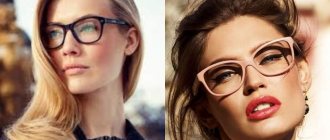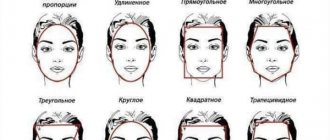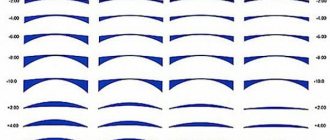You need to choose sunglasses taking into account several factors - lens color/shape, frame size, accessory material. If you successfully select a product based on your face type, then you will be able to hide its flaws, for example: a triangular face will be visually corrected with narrow glasses, and a round face with rectangular or square glasses.
Manufacturers have developed individual sunglasses for drivers - with polarized coating and photochromic ones, which ensure the absence of glare even when driving in the dark and in rainy weather. Corrective and “Anti-lights” are considered no less popular.
When choosing sunglasses, experts recommend paying attention to their cost: accessories that cost 200-300 rubles cannot guarantee reliable protection from ultraviolet, infrared rays and light. Really high-quality ones can cost from 2 thousand rubles to several dozen.
How to choose sunglasses by understanding the characteristics
Based on the characteristics of sunglasses, you should choose them according to certain parameters:
- frame and lens materials;
- level of protection from the harmful effects of ultraviolet (sun) rays;
- lens shape.
Since sunglasses have long been a fashion accessory, they come in different shapes and sizes, with lenses of different shades. And this parameter should also be taken into account when choosing.
| Lens color | Characteristics | When to wear | Examples |
| Chameleons, second name - photochromic | Depending on the brightness of the lighting, they can change the level of darkness | In any weather, at any time of the year, even indoors | |
| Green, gray | Protect from harmful sunlight without distorting the image and color in the visible picture | In the sun, in cloudy weather, you don’t need to shoot indoors | |
| Mirror | Reflect light as much as possible, therefore providing 100% protection | Recommended for wearing in winter when there is a lot of snow and sun, as well as in the mountains | |
| Golden, yellow | Can only block blue light | They are not worn at all in sunny weather, but they perfectly help solve the problem of ultraviolet “irradiation” in cloudy weather. | |
| Graduated, they are also called “mask” | Lenses are only half dark | Worn in any weather, at any time of the year. Suitable for driving vehicles | |
| Polarized | Do not allow very bright light to penetrate to the eyeball | It is worth wearing them on the sea coast, in the mountains |
Types and shapes of lenses
The correctly chosen shape and type of lenses will help transform a person’s entire appearance, and in order not to make a mistake, it is worth knowing what types of lenses are generally available on the market:
- corrective glass - capable, if necessary, of correcting visual acuity and at the same time protecting from the bright light of sunlight;
- graduated - the difference lies in the gradual transition from a dark shade of the coating to a lighter one, which is observed from top to bottom;
- organic - only the outer surface of the lens is painted;
- polarized - prevent glare from any reflective surfaces such as sand, snow, water, and so on;
- photochromic - can change the depth of darkness depending on the weather and brightness of light, the second name (popular) is “chameleons”.
The shape of the lenses can, in principle, be very different, and the choice must be made individually.
There are general recommendations from experts:
- square, rectangular lenses are absolutely not suitable for a face with pronounced details;
- round (a la cat Basilio) will look great only on narrow faces, when an elongated shape is noted;
- the famous “cat’s eye” should not be worn by those with round faces;
- “Aviators” are suitable only for strong-willed individuals with clearly prominent cheekbones and chin.
Lens material
We should also consider the material from which the lenses are made:
- Glass . This material does not transmit ultraviolet rays and reflects them, therefore it is often used to make mirror glasses. The disadvantage of glass lenses is their heavy weight and simultaneous fragility, which can lead to eye injury. Glass lenses will be extremely inconvenient for those people who lead an active lifestyle - they can fall at any time, break and injure their face.
Modern industry has begun producing special tempered glass, which increases the safety of glasses with such lenses. But even experts do not recommend buying them for children.
- Plastic . The advantages of the polymer material are light weight, minimal risk of injury, and a high level of protection from ultraviolet rays. This material is quite “soft”, so lenses of any shape can be made from it.
- Disadvantages: plastic scratches and rubs very easily and transmits a large amount of ultraviolet light. Therefore, glasses are not suitable for visiting the sea coast - a false eclipse effect is created for the pupil and it simply does not narrow.
If the choice is given to glasses with plastic lenses, then you will need to pay attention to the presence of a special protective coating.
What are the different frame materials?
Frames are also different, and first of all you need to decide on the choice of material:
- Plastic is a universal option and is used to make sunglasses of various types. This material is lightweight and has the ability to absorb paint, so the range of accessory choices is expanding. Polymer plastic is durable and does not crack even when exposed to aggressive external factors such as sea water, direct rays of the sun, rain and frost.
- Metal – can only be painted golden and is considered more durable than plastic. Metal frames are a classic accessory design, so they are appropriate to wear both at a young age and at an older age, regardless of a person’s social status in society.
The only caveat: when inspecting sunglasses, you need to pay attention to the places where the temples are attached: if the screws are tightened too tightly, then after a short period of use, small cracks will form on the lenses.
Exclusive, original models of sunglasses are made with wooden frames - only natural hardwood is used and treated with a special compound to extend the life of the accessory. Glasses with such frames are heavy, bulky, uncomfortable to wear, and crack quite quickly.
Level of ultraviolet protection, marking of light transmission categories
The degree of UV protection for all glasses is different, so you need to know the markings of light transmission categories in order to understand this criterion when choosing an accessory:
- UV is, in fact, the international designation for ultraviolet radiation and such markings should be included in the passport for any sunglasses;
- A and B - this is how the type of ultraviolet radiation is designated, from which a particular accessory protects; it is better to have 2 letters at once, but only the first is more common.
The categories of sun protection lines that comply with European standards are indicated separately:
- “zero” - the lenses have no shading at all, transmit 100% of ultraviolet rays, the eyes remain practically unprotected;
- “first” - special glasses, glasses are worn only when the sun is not active, transmit about 80-85% of ultraviolet rays, and experts consider them only a fashion accessory, and not protection from bright light;
- “second” - transmits on average 40% of ultraviolet rays, glasses with such lenses are excellent for wearing in sunny weather in central Russia;
- “third” - lenses transmit only 10% of sunlight (average), have a high level of eye protection, glasses with them can be worn in tropical countries and in the Far North;
- “fourth” - the throughput fluctuates within 5%, glasses with such lenses can be used in high mountains, but an accessory of such a high level of protection is prohibited for motorists to wear.
It is believed that any tinted lenses provide protection to the eyes from ultraviolet rays. But experts warn: some glasses can transmit large amounts of ultraviolet radiation, which will lead to spontaneous dilation of the pupil, and the result will be the penetration of a large amount of light into the eyes.
It is recommended for daily wear to purchase sunglasses with an average level of protection - categories 2 and 3, because too dark lenses will quickly tire your eyes.
Which color is better: bright, brown, black
It is better to choose lenses by color, taking into account the fact that such a coating complements the characteristics of sunglasses - for example, brown can relax the eyes, and orange, on the contrary, constantly keeps them tense.
What nuances need to be remembered when choosing lens color:
- yellow – make it possible to more accurately determine the distance to the desired object, relax the eyes, and increase the brightness/contrast of the visible “picture”;
- gray with a dark tint - the perception of the surrounding world and colors is as close to natural as possible;
- blue, cyan and other “cold” shades - completely disrupt the perception of the color scheme of the surrounding world, therefore they are prohibited from wearing while driving a car;
- brown - relaxes the eyes, increases the contrast of the external environment;
- pink – do not distort color perception, but provide minimal protection from the active sun;
- orange – protect from ultraviolet radiation, help improve the clarity of the visible image, but do not transmit some blue rays, which leads to incorrect perception of color shades;
- green – relieves the usual tension from the eyes, has a calming effect on the central nervous system, and can be worn on a daily basis.
Fashionable looks
Glasses will help you quickly diversify your look and make it special and unique. Gradient models have been a popular trend among the fair sex in recent years. Their specificity lies in the color of the lenses: they are darker on top and almost colorless below. Bright colors and colored glass can add zest to any look and decorate even a boring outfit.
REFERENCE! Men choose tighter “panoramic” models that have an elongated curved shape.
Thanks to the wide variety of models, you can choose sunglasses for any purpose: dating, travel, work or sports competition. However, do not forget that, first of all, these products must provide eye protection from exposure to ultraviolet radiation.
Making a pocket for a baby crib with your own hands
Style battle: Marilyn Monroe or Audrey Hepburn
How to try on a fashion accessory correctly
Trying on a fashion accessory correctly means following the following recommendations:
- do the fitting in front of a flat mirror that does not distort the image;
- sunlight at this moment should fall directly on the face - this way you can determine the comfort of darkening the lenses;
- the arms should fit snugly to the head, but not put pressure;
- putting on glasses, you should turn your head to the sides, tilt it and tilt it back - the accessory should remain in the “original position”;
- pay attention to obtaining images with glasses - objects should not be distorted;
- The darkening of the lenses should be uniform; if the bottom is light, discomfort may occur when worn.
If you are purchasing a branded product, you need to study its passport, check for markings on the degrees of sun protection and the brand mark on the temple (inner side, on the glass).
Frame and lens material
First, pay attention to the lenses. which glasses to choose for sunglasses - the glass that fashionistas are chasing is less scratched, but only partially blocks ultraviolet radiation. But high-quality polymers, like polycarbonate, prevent rays A and B from reaching the retina. Infrared rays are blocked only by polarized sunglasses , and classics, especially fashion ones, do not interfere with them at all.
Advice!
If you have to drive a car often, then it is best to leave your choice on plastic glasses, as they are safer in case of a possible accident (what to do if you get into an accident in Thailand?). Such glass will either simply fly out of the frame, or even if it breaks, the risk of injury is minimized.
The frame material can be any. Lightweight plastic has its advantages, for example, it is durable and lasts a long time. Metal models with wooden inserts look no less stylish, and they are stronger than plastic. It’s just important to carefully consider the places where the lenses are attached to the frame; if the metal frame is overtightened, cracks can form at the fixation points, they dramatically spoil the appearance of the accessory and reduce its service life.
Which sunglasses to choose: photochromic, polarized
Photochromic and with polarized coating - these are the sunglasses that are often recommended in optical stores, but you also need to be able to do them, for this it is important to know:
- The lenses are coated with a special coating that prevents glare and reflections;
- such an accessory can be worn even in the brightest light, aggressive sun in tropical, equatorial countries;
- Polarized glasses will help protect your eyes from blinding light at ski resorts.
Polarized glasses can be checked for quality directly during the selection process:
- ask the seller for a sheet of paper with any hologram that will be visible only with glasses;
- turn on the smartphone at full screen brightness and make the latter with a white background, then bring the gadget to your eyes and slowly turn the screen to the side - as soon as the light from the screen hits your eyes at an angle of 90 degrees, the lenses will darken to almost complete opacity;
- put one pair of polarized glasses on your face, bring the second one with the same coating to your eyes at a distance of 10-15 cm and start turning them - the lenses of the ones you are wearing should darken.
Photochromic glasses are “chameleons” that provide variable degrees of light transmission from the lenses. If, for example, direct rays of light/sun do not hit the glasses, then their lenses remain transparent. As soon as the rays are directed at them, they gradually darken, which makes the protection as high as possible.
Photochromic glasses
Which sunglasses are best for a motorist to buy?
It is believed that the best sunglasses for drivers are those with polarized lenses. And, indeed, they 100% protect the eyes from ultraviolet rays and glare - the latter are present on the highway at any time of the day: at night the headlights of oncoming cars glare, and in the daytime there is wet asphalt, snow on the side of the road, and the reflection of the sun from the dividing lines. protective devices.
But there are 3 other types of sunglasses that are great for drivers to wear:
- photochromic - provide the desired darkening depending on the time of day and the intensity of incoming daylight, artificial light;
- corrective – useful for drivers with reduced visual acuity; they are coated with a special coating against ultraviolet rays;
- “anti-headlights” - ideal for driving in fog, rain and snow; they reduce eye fatigue because they have red or yellow lenses.
Anti-Far glasses
The cheapest sunglasses for drivers are Anti-Fars; corrective glasses do not have a fixed price - they are selected strictly on an individual basis, but photochromic and polarizing ones (from well-known brands and of the highest quality) can cost from 3,000 to 50,000 rubles.
Face shape and glasses design
To look impressive in sunglasses, it is recommended to select models depending on your face shape:
- round – the shape of glasses in the form of a square or aviator model is suitable, they visually lengthen the oval of the face;
- square – it is necessary to choose models that have a rounded shape in order to soften the oval of the face and make it visually more round;
- triangular with a large forehead - it is necessary to select glasses that widen towards the bottom, so sharp facial features will not be visible, the forehead will appear visually smaller;
- oval - absolutely all types of glasses models will suit owners of this head shape.
To avoid errors in parameters, it is recommended not to order sunglasses online. It’s better to try them on first, look at them in the mirror, and only then make a purchase.
How to choose sunglasses for a woman
A woman should choose sunglasses not only by the color of the frame and lenses, but also by quality characteristics. If this accessory looks harmonious on the face, then it will be possible to hide its shortcomings and correct them.
For a round face
The round type has convex cheeks and the same, with slight deviations, width and height of the face. The purpose of sunglasses is to visually lengthen the contour of the face, so the best choice would be accessories with rectangular or square lenses. They should have rounded corners, and it is better to choose a frame that is bright and in unusual colors.
It is important not to wear glasses with massive frames, because even if you follow other recommendations, such an accessory will only worsen a woman’s appearance.
For square shape
An angular jaw, a pronounced forehead, “hidden” cheekbones are signs of a square face type; such geometry can be successfully hidden with well-chosen sunglasses. They should have rounded lines (at the top) and in no case straight. The frame can be massive, but not critically, because in this case it will only emphasize the massiveness of the face.
A frame can only be bright if it is thin. But experts recommend giving preference when choosing pastel, nude shades.
If a triangle
A triangular face is characterized by a narrow lower part and a wide low part - this imbalance needs to be corrected. Sunglasses with cat-eye lenses will cope with this task most successfully. You can also choose an accessory with oval lenses that are slightly narrowed downward.
It is strictly not recommended to choose round glasses, because they will make the upper part of the face look more massive. And square and rectangular ones will be superfluous - they will bring even greater disharmony to the entire appearance.
If you have an oblong face
An oblong face does not have pronounced cheekbones and cheeks, so you can wear plus size models with rounded frames. It is recommended to avoid glasses that are too narrow and those whose frames are characterized by clear, straight lines.
It will be successful to choose a frame that has a more pronounced, bright color in the upper part.
How do you know if your sunglasses are the wrong size?
- The frame protrudes beyond the contours of the face
- The frame covers a large area under the eyes
- The eyebrow line is hidden under glasses
- Glasses slide down when you tilt your head
- The lower part of the frame “lies” on the cheeks
- The contours of the face are strongly visible from behind the frames
Photos: Pinterest
Ideal fit of glasses - the eyes are located in the center of the lenses. Be sure to take pictures of yourself while selecting glasses so as not to forget how this or that model sits.
Photos: Pinterest
How to Wear Sunglasses
You need to wear sunglasses not only in sunny weather, but also in cloudy weather - this rule applies to the summer period. The fact is that ultraviolet rays easily penetrate clouds and clouds and exert their harmful effects on the eyes with no less intensity. It is not recommended to put glasses on your head (raise them on your hair), as this will damage the coating on the lenses. The most important thing is proper care of the accessory.
Rules of care
If you follow the rules for caring for sunglasses, you can count on their long-term use without loss of quality characteristics:
- the accessory is stored in a case or a special bag - this will protect the lenses from scratches, abrasions and prevent dust from accumulating in the corners of the frame, in the places where it is attached to the lenses;
- It is forbidden to place glasses on the table with the lenses down - even their high quality will not stop the appearance of roughness and scuffs;
- You can only wipe your sunglasses with a special microfiber cloth, because both the handkerchief and the edge of your clothing will leave a lot of lint and small scratches on the surface;
- You can and should wash glasses with warm water and soap; you can use special sprays for such complete cleaning, but you need to ensure that they do not contain aggressive components such as acetone, solvent, or abrasive particles.
You only need to wipe your sunglasses with a special napkin.
The frames are more resistant to external factors, you just need to protect the glasses from falling and any mechanical influences.
Effect of solar radiation (ultraviolet) on the eyes
Prolonged exposure to the sun without special protective glasses can cause adverse effects on vision. Maximum precautions in sunny weather should be taken by those who have poor health or various ophthalmological diseases.
The most unsafe periods for eyes not protected by special glasses are the early morning and the afternoon. If the sun is located low, its harmful effect on the eyes increases several times.
When such rays are reflected from a large surface of water bodies, the level of negative effects of ultraviolet radiation increases. In the process of selecting such products by type of protection, it is advisable to take into account exactly what effect rays of this type have on unprotected or poorly protected organs of vision.
How do sunglasses work?
The basic principle of sunglasses is that the lenses delay ultraviolet rays. Moreover, they protect a person not only from the sun, but also from aggressive light exposure, which is constantly present in urban environments, because the sun’s rays are reflected from mirror, glass, and polished surfaces.
Sunglasses also protect the eyes from infrared rays, and their effect on the retina is felt immediately - the eyes burn, they have “sand poured into them,” and they itch. Harm from ultraviolet and infrared rays to the eyes increases significantly if a person is near water or reflective surfaces.
Popular models
The most popular models of sunglasses are:
| Name | Description | Photo |
| Wayfarers | Plastic frame, solid frame, lenses have a trapezoidal shape. The corners of the frame can be rounded, smoothed, or clearly defined. The glasses are quite massive, so they are optimal for oval face types. Categorically not suitable for owners of triangular and square faces. | |
| Brawliners | The combined frame of the frame has a half-rim, the line is present only in the upper part of the accessory. Such models are suitable for those whose faces have a pear-shaped, trapezoidal shape. Can be worn on oval faces, but only if they have the correct proportions. | |
| Tisheydy | They are considered the most popular, are distinguished by their round shape and are popularly called “a la Harry Potter”. They have a metal or plastic frame, the frame is solid. Absolutely not suitable for a triangular face, but will help correct an oval type. | |
| "Cat's Eye" | The frames are always wide, made only of polymer plastic, the corners sharply “go” upward to the temples. This model is universal because it will suit any face type. These sunglasses are only worn by women. | |
| Aviators | The frame is metal, thin and solid, the lenses are slightly narrowed towards the bottom. They are suitable for almost all face types, but they should not be worn by those whose contour follows a pear or trapezoid with an extension to the chin. | |
| Dragonfly | The frames are almost always made of polymer plastic and are considered the largest of all offered models. These sunglasses are ideal for correcting triangular and diamond-shaped faces. The frames are often bright and unusual, which makes it possible to visually hide an overly large nose from others. | |
| Mask | The lens is one-piece (it only has a place cut out for the bridge of the nose), it fits the face perfectly, and there are no even minor gaps. The size range of this model is large; they are not suitable only for those with a triangular face type. |
The sports model of sunglasses is also considered popular, but it is not purchased as just an accessory. The model may have different colors of lenses and frames, but the latter is always made of plastic, and the former are often removable. The main disadvantage of such sunglasses is that they can only be worn with a sporty style of clothing.
Models of glasses for women and men
The above tips related to choosing glasses for different face shapes and the degree of protection are, in principle, suitable for both sexes. However, there are some nuances
, associated mainly with the choice of sunglasses by women. And they are more likely related to the choice of frame color, since we have already decided on other parameters.
Blondes have the least difficulty choosing the color of glasses frames. The fact is that almost any frame color
¸ including even the most acidic shades. But brunettes are advised to refrain from frames that are too dark in tone and very dark lenses.
However, glasses with dark frames and dark lenses can be chosen by women who prefer a strict business style. However, the best eyeglass frame color for brunettes is dark gray or silver.
. Dark frames are suitable for almost all men, unless, of course, there is a desire to shock others or create some kind of special image (a la the image of a dude).
Frame color for red and brightly colored hair
Green or pink hair is not uncommon these days. Redheads are, so to speak, stylish from birth.
. For people with this hair color, we can recommend frames in blue, purple or light green. Moreover, this applies to representatives of both sexes.
dark frames are recommended for men with light hair color
and frames of bright colors. Men with dark hair usually look better with light-colored frames.
How to choose sunglasses, what to look for when buying
Choosing sunglasses will be easy if you reduce all the important points of the process to a single list:
- First of all, you need to pay attention to the degree of protection from ultraviolet and infrared radiation. If you plan to wear the accessory in urban environments or rarely in nature, then you can opt for small indicators. Living in places with active sun requires the purchase of lenses with a high degree of protection.
- The level of light transmission is also important. Even if glasses protect your eyes from the sun as much as possible, this does not mean that they do not let light through. But the less it passes to the eyes, the more comfortable a person feels. You need to remember that for traveling in a car, for the city, you can buy glasses with light lenses, in all other cases with distinctly dark ones.
- Plastic frames are only suitable for freestyle, but if a person is often forced to attend negotiations, meet with investors and partners, and prefers a business style in clothing, then you should pay attention to products with a metal frame.
Watch the video on how to choose sunglasses:
As for the shape of lenses and frames, these are individual parameters and there simply cannot be general recommendations. The main thing is to know your face type and take this as a basis when making a choice.
UV protection levels for sunglasses
Ophthalmologists distinguish several degrees of protective qualities of such products:
- Minimal. The degree of protection is 10-15% . It is better to use such models in cloudy weather.
- Initial. Provides penetration from 40 to 75% of sunlight. These glasses are recommended to be worn in the morning and evening when the sun is gentle.
- Average. Capable of blocking up to 65% of sunlight . These models are recommended for hot sunny weather.
- Maximum. Transmits only 7-10% ultraviolet radiation . Used for maximum eye protection. Suitable for those who suffer from photophobia. Also suitable for fans of surfing and skiing.
Meaning of marking UVA or UVB radiation
Based on intensity level, UV rays are divided into:
- UVA radiation , which makes up about 90% of all UV radiation reaching the Earth's surface and is distinguished by its maximum penetration effect (long waves, the length of which can correspond to 320-400 nm).
- UVB radiation (medium waves, the length of which can be 280-320 nm). Rays that pose the greatest danger to the eyes, damaging the tissues of the organs of vision and causing sunstroke.
High-quality products always have manufacturer's markings corresponding to the ultraviolet transmission and spectrum of rays.
Other popular markings
Another type of marking, often used by manufacturers, will help you choose the most suitable model of such glasses. Thanks to such markings, you can find out about the transmittance of ultraviolet rays:
- High UV-protection - products with very dark lenses that provide the highest degree of protection against UV rays. An excellent option for relaxing in hot seaside resorts or in the mountains.
- The degree of transmittance of UVA rays is from 85 to 98%. It is recommended to use when the sun is not particularly scorching.
- Blocks up to 70% of dangerous rays of both types ( UVA and UVB ). A good choice for urban conditions.
- Cosmetic - sunglasses that block less than 50% of ultraviolet radiation. It is better not to use models of this type in the active sun, since they will not be able to provide one hundred percent protection to the organs of vision from such rays.
- General is a universal option with UV filters that blocks from 50 to 80% of UV rays. Such models are suitable for everyday eye protection in urban conditions, at mid-latitudes.











